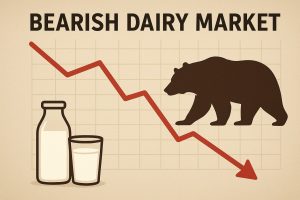
The current outbreak is affecting both dairy and poultry.
California dairy and poultry farms have been devastated by the current H5N1 outbreak. Could it be a preview of what a potential outbreak in Pennsylvania would look like?
“This is not ramping down. This is still coming on pretty strong,” said Dr. Alex Hamberg, Pennsylvania state veterinarian, earlier this week in an update to state dairy and poultry leaders.
The situation in California is concerning and one that farmers should keep a close eye on, he said. Over the past 30 days, more than 260 positive cases of H5N1 on dairy farms have been reported, most of those in California. At the same time, the Golden State has also seen 23 positive H5N1 cases on poultry farms — with many of those farms in the same areas.
“There is a lot of interaction between those two species in California,” Hamberg said. “There is a lot of virus. Some places can’t restock [animals] because of so much virus. So, it’s causing a lot of problems.”
Given the density of dairy and poultry farms in south-central and southeast Pennsylvania — many on the same farm — Hamberg said the effects of an H5N1 outbreak could be devastating.
“If you put the two together, there is quite a bit of overlap,” he said. “So, if the strain came in, it could cause very serious problems here, if there is no early detection and stamping it out.”
The good news, though, is that the current strain affecting dairies, H5N1 genotype B3.13, has not established a natural reservoir such as in wild birds. So, if it can be found in time and stamped out, it could get eliminated, Hamberg said.
Based on available data, Hamberg said the current outbreak on dairies is causing farms to experience a 20% reduction in milk production, long-term decreases in production and higher-than-normal somatic cell counts.
He said California’s outbreak is also leading to higher labor costs, as many workers are having to treat sicker cows for longer, causing worker shortages in other areas of farms. Some herds have seen cull rates as high as 50%, even though H5N1 is largely considered nonlethal to cows.
“It’s certainly affecting overall herd health,” Hamberg said.
More farms being tested
Late last month, Pennsylvania announced mandatory bulk milk testing at processing plants in response to low enrollment in two voluntary surveillance programs the state rolled out earlier this year.
Hamberg said the state has received more than 170 milk samples, representing 759 farms and 26 processors. All milk routes in the state must be sampled by Dec. 10, with additional mandatory testing every 14 days.
“Early detection can prevent widespread disease,” he said. “We just weren’t getting the surveillance we needed.”
Sampling is done at the tanker truck level and requires no effort from dairy farms. However, it does require farms to get a premises ID, although Hamberg added that there is no hard deadline for farms to get it.
A positive test on a dairy farm, he said, would initiate a mandatory quarantine of dairy farms within a 1.86-mile radius and weekly herd milk samples from all farms in the affected zone.
Hamberg once again encouraged dairy farms to have biosecurity plans on file in case an outbreak occurs. Farms with an approved biosecurity plan — including one developed by the Farmers Assuring Responsible Management program — would be eligible for a movement permit from the department to continue shipping milk if the farm were in a quarantine zone.
He also encouraged farms to do their own voluntary bulk milk sampling, as this would allow farms in good standing to move cows across state lines without individual testing of cows.
What to look for
Most dairy cows recover from H5N1, but it will likely drop milk production. Here are symptoms to look out for:
-
reduced milk production or milk that is thicker, more concentrated, or colostrum-like
-
decreased feed consumption
-
abnormal feces that are tacky or loose
-
lethargy
-
dehydration
-
fever
-
dry manure, diarrhea, constipation and loss of appetite
Preventing spread
Unlike H5N1 in commercial poultry, which spreads because of wild birds encountering commercial flocks, this substrain spreads among people encountering sick animals, by contaminated farm equipment and tools, and from cows that are infected but not showing symptoms.
Cornell recommends the following steps to prevent infection:
-
Pause or cancel nonessential farm visits.
-
Assign a biosecurity manager to monitor the situation and develop a farm-specific biosecurity plan.
-
Notify a vet if cows present symptoms such as discolored milk, decreased rumination and fever.
-
Report findings of odd behaviors, and increased numbers of dead wild birds, cats, skunks or raccoons.
-
Avoid importing cattle from affected farms.
-
Discourage wild birds from entering farms, waterers and feed sources.
-
Clean and disinfect waterers daily.
You can now read the most important #news on #eDairyNews #Whatsapp channels!!!
🇺🇸 eDairy News INGLÊS: https://whatsapp.com/channel/0029VaKsjzGDTkJyIN6hcP1K

























